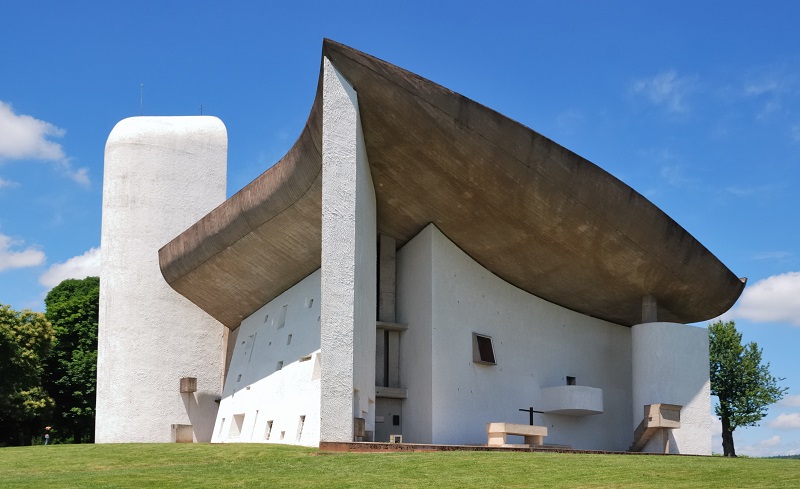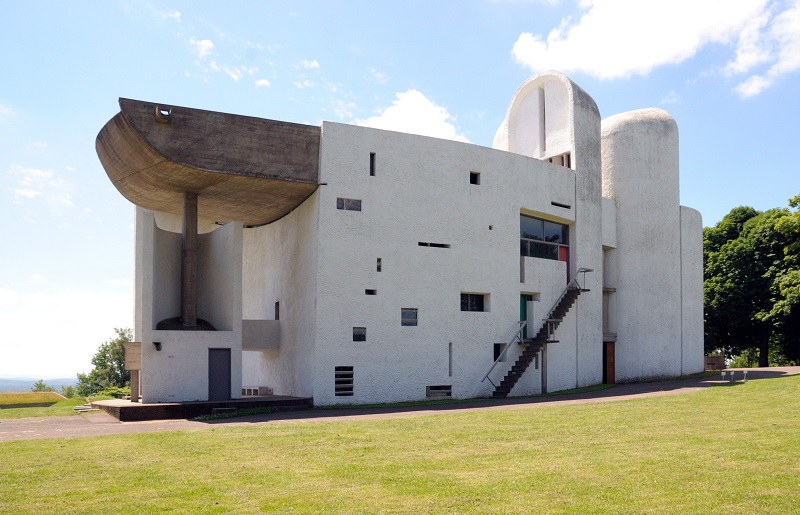Notre Dame du Haut
Contents |
[edit] Introduction
Notre Dame du Haut is a Roman Catholic chapel designed by Le Corbusier. Located on a hill near Belfort, Ronchamp, France, it is widely considered one of the most important buildings of the 20th century.
Commissioned to design the chapel in 1950, Le Corbusier saw an opportunity to depart from his trademark principles of standardisation and ‘machine aesthetic’ in response to the site, both physically because of the hillside location, and in terms of its historical legacy as a place of worship.
Notre Dame du Haut was built on the site of a 4th century Christian stone chapel which had been largely destroyed during the Second World War. Completed in 1955, Le Corbusier's chapel represents a defining move away from the characteristically sparse and functionalist form of Modernism, and today is regarded as one of his finest achievements.
[edit] Design and construction
Le Corbusier focussed on spatial purity and an uncomplicated design – two entrances, an altar and three chapels.
The building's envelope is formed by thick, gently-curving walls which provide structural support for a massive curvilinear roof and give the building its sculptural character. They also act as acoustic amplifiers, helping to reflect sound out over the fields.
The aerodynamic design of the monumental, curved concrete roof mimics the curvature of a wing and, despite its massive and heavy form, gives the appearance of weightlessness. The roof is supported by columns embedded in the walls rather than the walls themselves, making it appear to float above the building. The 10 cm gap between the roof and walls allows light to seep into the chapel.
Le Corbusier focused considerable time on the design of the south wall. It begins as a point on the east end, then expands to 10 ft thick on its west side, curving towards the south. The window openings slant towards their centres at varying angles, letting light enter the building in different directions.
Despite the complex layout suggested by the external appearance of the chapel, the interior is rather simple in plan. Le Corbusier’s intention was to create a meditative and reflective space. This is achieved in part by the stark white walls combined with the irregular arrangement of windows, which are glazed with a mixture of clear and coloured glass.
Three thick white walls curve inwards, creating smaller chapels at the sides of the main space. One is painted bright red, the other white. The internal and external walls are finished with mortar, sprayed onto the surfaces and whitewashed or painted. The roof is left raw.
The slope of the site is followed by the concrete floor towards the main altar. The floor is divided into a gridded pattern based on Le Corbusier’s innovative, modulor system of proportions.
[edit] Legacy
Despite being seen as a radical departure for Le Corbusier, the building actually adheres to many of the same principles of purity, openness and communality that informed his earlier work. Nevertheless, it was a contextual response to the site which inspired Le Corbusier to move away from the mechanistic style that he was known for at the time.
Today, the chapel remains an operational religious building, under the guardianship of a private foundation and welcomes 80,000 visitors a year.
[edit] Find out more
[edit] Related articles on Designing Buildings Wiki
Featured articles and news
Latest Build UK Building Safety Regime explainer published
Key elements in one short, now updated document.
UKGBC launch the UK Climate Resilience Roadmap
First guidance of its kind on direct climate impacts for the built environment and how it can adapt.
CLC Health, Safety and Wellbeing Strategy 2025
Launched by the Minister for Industry to look at fatalities on site, improving mental health and other issues.
One of the most impressive Victorian architects. Book review.
Common Assessment Standard now with building safety
New CAS update now includes mandatory building safety questions.
RTPI leader to become new CIOB Chief Executive Officer
Dr Victoria Hills MRTPI, FICE to take over after Caroline Gumble’s departure.
Social and affordable housing, a long term plan for delivery
The “Delivering a Decade of Renewal for Social and Affordable Housing” strategy sets out future path.
A change to adoptive architecture
Effects of global weather warming on architectural detailing, material choice and human interaction.
The proposed publicly owned and backed subsidiary of Homes England, to facilitate new homes.
How big is the problem and what can we do to mitigate the effects?
Overheating guidance and tools for building designers
A number of cool guides to help with the heat.
The UK's Modern Industrial Strategy: A 10 year plan
Previous consultation criticism, current key elements and general support with some persisting reservations.
Building Safety Regulator reforms
New roles, new staff and a new fast track service pave the way for a single construction regulator.
Architectural Technologist CPDs and Communications
CIAT CPD… and how you can do it!
Cooling centres and cool spaces
Managing extreme heat in cities by directing the public to places for heat stress relief and water sources.
Winter gardens: A brief history and warm variations
Extending the season with glass in different forms and terms.
Restoring Great Yarmouth's Winter Gardens
Transforming one of the least sustainable constructions imaginable.

























